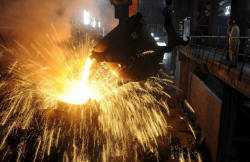|
Back from the dead? Chinese
iron ore miners plot return as prices surge
 Send a link to a friend
Send a link to a friend
 [March 02, 2017]
By Manolo Serapio Jr [March 02, 2017]
By Manolo Serapio Jr
MANILA
(Reuters) - Rocketing iron ore prices may prompt Chinese producers to
reopen mines shuttered years ago in a sector downturn, potentially
tightening the market for marginal foreign suppliers to the world's
biggest importing country, industry executives say.
A revival could help Chinese steel mills cut raw material import costs,
boosting margins amid rising steel prices. If more domestic ore is
produced, mills could also use that as leverage to push for better deals
on seaborne imports from top suppliers like Vale <VALE5.SA>, Rio Tinto <RIO.AX><RIO.L>
and BHP Billiton <BHP.AX><BLT.L>, traders say.
A booming Chinese steel market pushed iron ore <.IO62-CNO=MB> to $94.86
a tonne last month, its strongest since August 2014. With Beijing
expected to boost infrastructure spending, the raw material looks set to
rally further, making domestic production more viable.
"Quite a few Chinese iron ore miners are planning to come back and
reopen their mines," said Pan Guocheng, head of medium-sized miner China
Hanking Holdings Ltd <3788.HK>. While low prices led to closure of more
than a third of China's iron ore capacity since 2013, Pan expects nearly
half of those mines to restart - if the price stays above $80 for
another six months.

Hanking is now considering restarting one of three mines it closed when
times were leaner. "If the price will stay high," said Pan, "we are
going to seriously re-evaluate if that mine should be reopened."
A wave of mine reopenings won't present any immediate threat to Vale,
Rio Tinto and BHP Billiton, giants that supply top-grade material that's
an essential element of the input mix used in steel mill blast furnaces.
What's more, Beijing's tighter environmental rules could make life
difficult for returning mines, analysts have warned.
BARGAINING CHIP
Raw Chinese iron ore only has iron content of about 20 percent, compared
to more than 60 percent mined by Vale, Rio and BHP. But processed
Chinese ore can go up to 66 percent.
Some mills prefer to use the best grades of Chinese iron ore they can
find, rather than lower grade material from overseas.
[to top of second column] |

An employee monitors molten iron being poured into a container at a
steel plant in Hefei, Anhui province September 9, 2013.
REUTERS/Stringer/File Photo

"We are looking to get more local iron ore but we cannot find a lot of
it now," said an official from a steel mill in southeastern China,
speaking on condition of anonymity because he was not authorized to
speak to media. "I think they're just preparing to restart."
Hanking's Pan said China's best grade ores are competitive with lower
grade material from Australia, like those shipped by Fortescue Metals
Group.
But inland Chinese mills buy Fortescue's ore to blend with domestic
high-grade ore, Fortescue Chief Executive Nev Power said. "Demand...
remains strong and we are making very strong margins at the prevailing
market price," Power told Reuters by email.
Nonetheless, traders are betting that if more domestic high-grade iron
ore is produced, Chinese mills could use it as bargaining chip with
foreign suppliers.
"Mills may use it as leverage - if imported price is too high they will
shift to domestic ore," said one Shanghai-based trader who declined to
be identified.
For a Graphic on Rising iron ore prices lure back shuttered Chinese
miners, click: http://reut.rs/2luIQJA
(Reporting by Manolo Serapio Jr.; Editing by Kenneth Maxwell)
[© 2017 Thomson Reuters. All rights
reserved.] Copyright 2017 Reuters. All rights reserved. This material may not be published,
broadcast, rewritten or redistributed.
 |